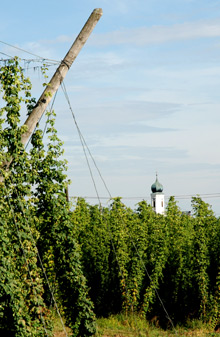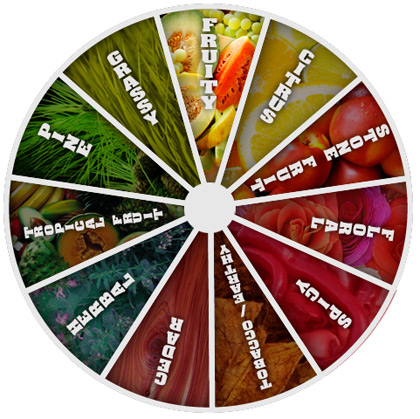If I had a blueberry anosmia1 this would make more sense, but I can identify blueberries in a blind tasting, or blueberry muffins or even blueberry beer. So why, when I smell a beer rich with Mosaic hop aroma don’t I perceive blueberries? Or when I take a deep whiff of Sierra Nevada Harvest Single IPA with what the label calls “Yakima #291″ hops”?
This really doesn’t bother me much. It could be worse. One-third of the population is blind to beta-ionone, a compound with a floral note particularly prominent in Saaz hops. I’m not in that group. It would suck not to be able to fully appreciate Saaz.
But why did the guy pouring in a Santa Barbara area wine tasting room last week say, “Now, Mosaic, there’s a blueberry hop”? It’s certainly not the first time I’ve heard somebody say that. Or how about this description of the Harvest Single IPA at the Sierra Nevada web site? “Blueberry in a beer! The consensus? That’s flavor fit for a bottle.” OK, it doesn’t really bother me that much. There are plenty of reasons that smell is referred to as the “most enigmatic of our senses.”
But it’s interesting you and I might rate blueberry aroma equally intense in one case, say a pie, and differently in another — simply because other aroma compounds are present. Before I head down that rabbit hole, back to the Harvest Single IPA, which has been hard to come by in our parts but we found easily last week in California.
As much as the mysteries of aroma fascinate me, so do the ins and outs of hop genetics. (So this might be the time you want to gently ease your way to another ready.) Mosaic is a daughter of Simcoe and a male plant called 986-2. Simcoe is a bit of a pungent brute, its aroma a calling card for American-style IPAs, sometimes called dank and, depending on your genetic disposition, downright “catty.”
HBC 291 — the name it was patented under, but not the name it will have if it goes into wider production — is a daughter of Glacier and a male called 9902(2). Glacier is much more demure than Simcoe, though not nearly as popular. Farmers planted about 1,260 acres of Simcoe in 2013, compared to less than 100 of Glacier. Its stone fruit character, notably peach, apparently is not as hip. Glacier is a daughter of the endangered French variety Strisselspalt, one of those hops I fear we will miss deeply when she is gone.
Before I lapse into further melancholy, the point here is that two very different mothers produced hops that when introduced into beer2 contribute to a blueberry aroma. Or don’t.
*****
1 Anosmia in a condition in which a person with an otherwise normal sense of smell cannot detect a specific type of odor molecule. It may also describe a complete loss of smell, which may or may not be temporary. The former is rather common, the latter depressing and much more rare.
2 HBC 291 was one of the hops available to evaluate last year when I spoke at Hop Union’s Hop & Brew School. It is important to remember that what you smell from a raw hop doesn’t necessarily translate into the same aroma in a beer. The interaction with yeast changes compounds. Anyway, HBC was the most pleasant of the varieties we smelled, HBC 438 as the most divisive (I was in the “love it” camp), and Mosaic sucked, reeking of diesel fuel (not indicative of the overall crop). My notes for HBC 291 describe it as “really clean, floral/spicy, a herbaceous note reminiscent of Centennial.” Still nothing about blueberry.
 America’s smaller brewers — smaller meaning Boston Beer Company on down — produced 7.4 percent of the beer sold domestically in 2013 and used 52 percent of the hops grown domestically.
America’s smaller brewers — smaller meaning Boston Beer Company on down — produced 7.4 percent of the beer sold domestically in 2013 and used 52 percent of the hops grown domestically. Brewer’s Gold was bred in 1917 at Wye College 60 miles east of London and released for cultivation in 1934. With her, and her sister Bullion, breeder E.S. Salmon took hops in a new direction. He was the first to cross pollinate genetically distinct American hops with European hops. When Salmon began at Wye College, hops contained 4 percent alpha acids on average and 6 percent at the most. Breeders have since released hops with more than 20 percent alpha acids, almost always using cultivars that lead back to Salmon. They not only contain more alpha acids, but different odor compounds. Thus brewers can use “exotic” hop varieties like Citra and Mosaic from the United States, Galaxy from Australia, or Mandarina Bavaria from Germany.
Brewer’s Gold was bred in 1917 at Wye College 60 miles east of London and released for cultivation in 1934. With her, and her sister Bullion, breeder E.S. Salmon took hops in a new direction. He was the first to cross pollinate genetically distinct American hops with European hops. When Salmon began at Wye College, hops contained 4 percent alpha acids on average and 6 percent at the most. Breeders have since released hops with more than 20 percent alpha acids, almost always using cultivars that lead back to Salmon. They not only contain more alpha acids, but different odor compounds. Thus brewers can use “exotic” hop varieties like Citra and Mosaic from the United States, Galaxy from Australia, or Mandarina Bavaria from Germany.